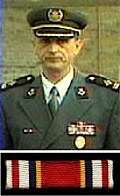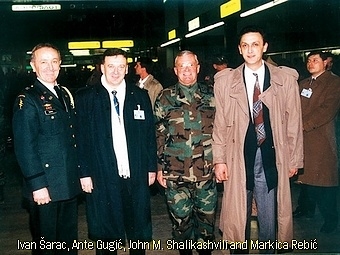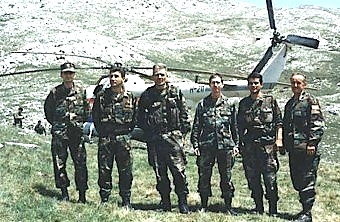Thrilled with Operation Flash, President Clinton gave
the go ahead for Operation Storm
By Ivo Pukanic, Nacional (Zagreb) May 24, 2005
The United States was actively involved in the preparation, monitoring and initiation of Operation Storm: the green light from President Clinton was passed on by the US military attache in Zagreb, and the operations were transmitted in real time to the Pentagon
Considering that the US was much more interested in the situation in BiH than in Croatia, they asked Croatia to permit them to install a military base with unmanned aircraft. The United States not only monitored the complete Operation Storm, but they also actively participated with the Croatian Military in its preparation, and in the end directly initiated the operation. The green light from the White House and then President Clinton for Operation Storm was passed on by Colonel Richard C. Herrick, then US military attache in Zagreb. Several days prior to the commencement of Operation Storm, Herrick visited Markica Rebic in Zagreb. Rebic, Miroslav Tudjman, then director of HIS and Miro Medimurac, then head of SIS, held the most intensive communications with the American military and intelligence agencies.
 As such, in 1996, Rebic was awarded the Meritorius Service Medal by Peter Galbraith, then US Ambassador to Croatia. As such, in 1996, Rebic was awarded the Meritorius Service Medal by Peter Galbraith, then US Ambassador to Croatia.
Herrick passed on the message that the US had no opposition to the beginning of Operation Storm, that the operation had to be 'clean and fast' and had to be completed in 5 days time. As Nacional has learned, Rebic was surprised that such an important political and military message would be passed on through those channels, and following Herrick's visit, he immediately informed the state administration of the message in writing, and there is certain record of this today in the archives. As such, it is important to note the Ambassador Peter Galbraith was completely left out of the chain of 'command', and that this message came directly from President Clinton, Anthony Lake (then National Security Advisor) and Willian Perry (then Defense Secretary) via Rebic to Minister Gojko Susak and President Tudjman.
This was the climax of the cooperation between the US and Croatia, which began to develop in 1992 at the beginning of the Serbian-Muslim war. In 1995, Clinton was preparing for his re-election, and Bob Dole was the Republican candidate who had requested that Congress remove the arms embargo for the Muslims in BiH. For Clinton, the Balkans became an important issue due to internal matters in the US and his stay in the White House. In their strategy to resolve the crisis, they decided to use Croatia to attack the Serbian forces in BiH, and therefore the Split Declaration was signed by Izetbegovic and Tudjman, which permitted the entry of HV forces under the leadership of Ante Gotovina into BiH for the purposes of cooperation with Army BiH. In order to realize that operation, HV had to climb the Dinarid mountains above Knin and liberate the city and Krajina through Operation Storm, and then immediately transfer their troops into BiH in order to pressure the Serbs and force Milosevic to sign the Peace Accord in Dayton.
This was a battle against the clock for Clinton, for he needed a quick solution to the crisis in order to halt Dole's initiative and to prove himself before his voters as a decisive president who could resolve such great crises such as the one in the former Yugoslavia, the horrors of which were shown daily on CNN and other American TV stations. In order to keep the English and French off his back, Clinton bypassed the classical diplomatic channels, in order to be able to claim that he had not participated if the operation were to go sour. However, considering that the operation, led by Richard Holbrooke on his behalf, ended successfully, and the men emphasized their success in their respective books.
 |
 |
 |
 |
 |
MR. RICHARD C. HERRICK, FAO (48C), LTC (R), USA.
Currently serving as Chief of the Asia/Pacific Division at DIA, Lieutenant Colonel Herrick has served as the Defense and Army Attaché in Croatia, the Army Attaché in Yugoslavia, a staff officer at the FAO Proponent Office (DCSOPS-DA), a regional analyst (ITAC), a Rand Arroyo Fellow, and a Engineer battalion XO. He trained under the old Soviet/E.
...
Currently working as a Branch Chief at DIA, Lieutenant Colonel Herrick has served as the Defense and Army Attach#233 in Croatia, the Army Attach#233 in Yugoslavia, a staff officer at the FAO Proponent Office (DCSOPS-DA), a regional analyst (ITAC), a Rand Arroyo Fellow, and a Engineer battalion XO. He trained under the old Soviet/E.
|  |  | |  |  |  |  |  | |
The first contact at the highest intelligence levels began in 1992, when James Clapper was director of DIA (the Defense Intelligence Agency). His men in Croatia were Colonel Richard Herrick and his assistant Ivan Sarac. Sarac was a fourth order [master] sergeant, the highest rank for a non-commissioned officer. Of Croatian descent, he emigrated to the US when he was 17 years old. After a few years, he enlisted in the army and was sent to Zagreb at the beginning of the war there as he was familiar with the circumstances and knew the language. Colonel Herrick was a construction engineer, however, over time he climbed the ladder in the American military and became one of Clapper's most trusted men.
Quickly a sort of 'trade' between the two agencies began. Croatia gave DIA Russian 500 kg underwater mines and the most modern Russian torpedoes as well as the encryption codes used by the Yugoslav Army and the Russian army. These weapons were transferred to the US via the Split airport. When the transport was conducted, the entire airport was closed off. Hercules C-130s landed in the night, the arms were loaded and transferred to the US or one of their European bases under the greatest security measures. Also, the Croatian agency revealed the location of a chemical weapons factory in Bijelo polje near Mostar which the Serbs had transferred to Serbia. This was a well-concealed factory which was unknown even to General Bienefeld, who was the greatest expert for chemical weapons in Croatia. With the help of samples found, the American experts were able to uncover all the types of toxins produced there which had possibly been sold to Iraq or other potential enemies of the US. This was only the beginning of cooperation, by which the US immediately delivered wiretapping equipment aimed at monitoring Serbia and Montenegro, a system which could simultaneously record 20,000 telephone conversations. This cooperation was conducted with the US NSA.
 Prior to Storm, the operations Summer 94 and Summer 95 had to be carried out. In planning the operations of bringing Croatian troops above Knin, the US assisted in the intelligence part of the operations. In order to precisely plan the penetration into the Bosnian mountains inland of Knin, much information was needed on the movement of Serbian troops, their communication system, codes and establishment of shelling points.
Prior to Storm, the operations Summer 94 and Summer 95 had to be carried out. In planning the operations of bringing Croatian troops above Knin, the US assisted in the intelligence part of the operations. In order to precisely plan the penetration into the Bosnian mountains inland of Knin, much information was needed on the movement of Serbian troops, their communication system, codes and establishment of shelling points.
Considering that the US was much more interested in the situation in BiH than in Croatia, they asked Croatia to permit them to install a military base with unmanned aircraft. The basic condition was that this be the best-kept secret, so that it would not appear that the US had taken sides in this war. The island of Brac was selected, as it could be well protected. There all the equipment and personnel led by the CIA experts, with the long-range unmanned aircraft which could cover the entire territory of BiH to the Serbian corridor on the Sava River. The entire Krajina region in Croatia was also in its range. At that time, no one had any idea what was going on and what was being hidden on the island of Brac. Nor did the US allies, the Germans, have any idea. They sent their military attache there on 1 January 1994. He hired a rent-a-car and drove the outer fence of the base and began taking pictures, thinking that the alertness in the base had faltered on New Year's Day. However, he was quickly spotted by SIS and arrested. Only when he was brought into Gotovina for questioning was it learned that this was the German military attache in Zagreb, Hans Schwan.
 After this incident, the entire base was transferred to Sepurina near Zadar, and a triple line of defense placed around it. Equipment was brought in from the US overnight, and from Sepurina, the unmanned aircraft could cover every corner of Krajina and BiH. The Americans had a silent agreement with HV to hand over all the photos of the terrain and the Serbian troops, while the images were transferred via satellite in real time to the Pentagon. Three US and three Croatian officers monitored the situation at all times.
After this incident, the entire base was transferred to Sepurina near Zadar, and a triple line of defense placed around it. Equipment was brought in from the US overnight, and from Sepurina, the unmanned aircraft could cover every corner of Krajina and BiH. The Americans had a silent agreement with HV to hand over all the photos of the terrain and the Serbian troops, while the images were transferred via satellite in real time to the Pentagon. Three US and three Croatian officers monitored the situation at all times.
Prior to Operation Flash, which was supposed to serve as a dress rehearsal for Storm, at exactly midnight, six hours prior to the beginning of the operation, Herrick and Sarac were called into the police and were informed that the planned action would begin in a few hours time. In the Police Ministry, at exactly midnight, the staff of Operation Flash was formed, which was transferred to the Defense Ministry at 6 a.m. When the staff was moved, the American military attache moved with it. He constantly requested updates and sent them directly to Clinton in the White House. Each morning, the American President was informed of the preparations and every part of the operation. The Americans were thrilled by the way Flash was carried out, they realized that this model of cooperation with the Croatians was ideal, and could be decisive in the battle against Milosevic in BiH and could ultimately result in removing him from power. The Pentagon coordinated the entire action via Richard Herrick, and the CIA activities were coordinated by Marc Kelton, head of the CIA branch in Zagreb, who cooperated closely with Miroslav Tudjman, then head of HIS.
At the time Storm was under preparation, the Americans supplied HV with intelligence on the movements of Serbs in Krajina and the movements of YNA on the eastern borders of Croatia. They feared that Milosevic would launch a counter-attack with two tank brigades in eastern Slavonia if the Croats launched an attack on Knin. Through intensive monitoring of communications
between Belgrade and Knin, and within Serbia, they came to the conclusion that there would be no counter-attack. It was risky that the Serbs might launch an attack from Knin itself when Gotovina and his units arrived on the Dinarid mountains above the city. Had the unmanned aircraft and monitoring showed offensive maneuvers by the troops, Storm would have begun ten days earlier.
In the wee hours of 4 August 1995, the Croatian units were issued the command to turn off all telecommunications devices between midnight and 4 am. Later it was learned that the Americans had used that time to electronically intercept and destroy the Serbian telecommunications devices.
HV was left with one hour, from 4-5 AM to use their radio ties to coordinate the operation. Just prior to Storm, the American military attache was again called to the operation staff. Ivan Sarac was again with him. One or two days prior to Storm, Herrick, who had prepared Storm with the Croatian officers and gave the operation the green light on Clinton's behalf, was replaced by Colonel John Sadler. At exactly midnight, they arrived at the operative staff and from there followed all the events in the field. This time, the entire Operation was transmitted in real time via satellite to the Pentagon, where these images remain archived today. The signal transmitted to the signal by the Americans was also received by HV, and with the help of those images, the firing upon Serbian positions and the military base near Knin could be monitored to within millimeters. In addition to electronically destroying the Serbian communications, the US military also acted militarily against the Serbian positions, when it fired on the anti-aircraft battery
near Knin from American combat planes that flew over the battle area. That news was released only once, on the 6 o'clock news. Afterwards, the US sharply condemned this, and that news was never repeated. No one believed the official American explanation for the rocket attack, and today the general perception is that this was direct US assistance to HV, only that even ten years after Storm this must not be admitted, due to US-British relations, as Britain had a completely different perspective on how to resolve the Balkan issue. And it still does today. The US was thrilled with the how fast and clean the operation was conducted, and with its outcome, which permitted the lightning fast entry of HV into BiH and penetration all the way to Banja Luka and, finally, Belgrade's consent to sign the Dayton Accord. The American control and satisfaction of the complete operation was later confirmed in the statements that the operation was carried out properly, and as such, the US-Croatian cooperation in intelligence and military matters intensified. General Colonel Patrick Hughes, Clapper's successor as director of DIA, visited Croatia, intensified cooperation in the sector of electronic monitoring of Serbia and Montenegro, other intelligence was swapped, MPRI began its intensive training of the Croatian military and Rebic was decorated for his efforts.
The first word that Croatian officers might have to stand trial for the events during Storm was heard in 1997. The US immediately responded and requested on a dozen occasions in discussions with the Hague Prosecutor that Storm, as a militarily-clean operation, be left alone, as Nacional has learned from a high-ranking diplomatic source. At that time, there was a
problem concerning the extradition of Mladen Naletilic Tuta to the Hague, and the US promised Croatia that the Hague would not raise charges for Storm if they handed Naletilic over. Naletilic was extradited, and Carla Del Ponte outwitted the American administration and began with her demands that the Croatian generals be investigated as suspects in Storm. The US was dismayed but was not allowed to show this, trying to resolve the matter through quiet diplomacy instead, which to this day has not succeeded. Therefore it would be a step in the right direction for the Hague to request that the Pentagon hand over all the images recorded by the 'Predator' unmanned aircraft during and after Storm.
Furthermore, for the interests of truth, all of the high ranking American military and intelligence officers involved in the entire operation, which ended the war in the Balkans and removed Milosevic from power, should be called to testify in the Hague. Those responsible for the crimes which took place after the operation are known, and they are the ones which should stand before the court, as they should have eight or nine years ago. Had these men been tried then, Carla Del Ponte today would have no aces up her
sleeve, and Croatia would not have the problems it has, with the entire operation proclaimed a 'criminal operation' and the entire state administration of the time a 'criminal organization'. |


 U.S. Awards Nazi Collaborator "Legion of Merit"
U.S. Awards Nazi Collaborator "Legion of Merit" 

 U.S. Awards Nazi Collaborator "Legion of Merit"
U.S. Awards Nazi Collaborator "Legion of Merit"